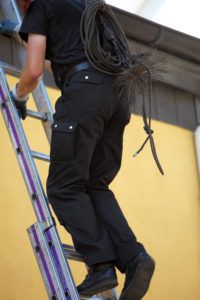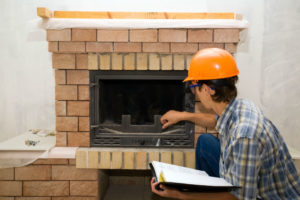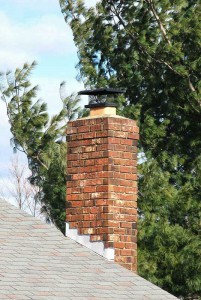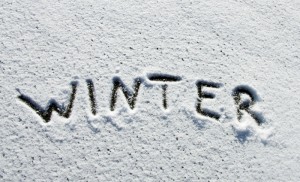Winter in Minnesota arrives sooner, lasts longer, and is significantly colder than many other states. Because of this, fireplaces are often an integral part of keeping our homes – and our families – warm all winter.
While our fireplaces may be used heavily during the fall and winter, many chimney repairs cannot be made in cold weather. This sometimes leads homeowners to rush, hiring the first company they find instead of one that can provide long-term, quality repair.
How masonry damage affects your chimney
Bricks and mortar are built to withstand the elements. However, even the best-constructed chimneys may suffer due to Minnesota’s extremely harsh winters. Because of this, repairs may be necessary to keep the fireplace burning safely and efficiently.
One of the most common causes of masonry damage is the freeze-thaw cycle. The freeze-thaw cycle occurs when small amounts of water become trapped in the bricks and mortar of the chimney. When temperatures drop below zero the water freezes and expands; the creates progressively larger and larger holes and cracks in the chimney.
Finding the right chimney repair company
If the fireplace is not working properly or the chimney is starting to show signs of wear and tear, it is important to have these issues addressed as soon as possible – particularly in a part of the country where winter masonry repairs are often impossible. However, it is still worth the effort to spend time researching a chimney company before hiring. This can help ensure you hire a qualified, trained mason – even if it means waiting until spring to have repairs made.
Things to look for in a masonry repair company
Not all masonry repair companies or chimney sweeps are created equally. Because of this, it is important that homeowners do their research before jumping into repairs with a new company. Unfortunately, this sometimes means waiting until spring until repairs can be made. The following are a few of the things to look for before hiring a masonry repair company.
- Contractor’s license – A reputable repair company should hold a contractor’s license. Not only does this ensure they are qualified to make repairs, but it also protects homeowners; in the event, there is a dispute over the repairs, the state’s dispute resolution program may help compensate homeowners.
- Proof of insurance – Verifying proof of insurance before a chimney company starts making repairs protects both homeowners and workers. For homeowners, insurance ensures you will not be sued in case a worker is damaged as well as protecting you in the event damages are made to the home.
- Reputation and reviews – Most reputable companies are happy to provide potential customers with a list of reviews or referrals. Likewise, the Better Business Bureau or websites like Angie’s List can be helpful in vetting the reputation of potential companies.
In northern states like Minnesota, chimney repairs need to be made before Mother Nature drops the temperature below freezing until spring. However, it is still important to research the company you are hiring before trusting them to work on your fireplace or chimney. For more information on what to look for when hiring a chimney sweep company, contact the CSIA-certified chimney sweeps at Jack Pixley Sweeps today.
After a long winter of use, your fireplace and chimney are ready for some TLC! To avoid the spring rush, schedule your chimney sweeping and inspection now; customers who book March 31st can save $40 on chimney sweepings and inspections or $10 on gas fireplace maintenance or dryer vent cleaning!
The importance of annual maintenance
When it comes to keeping your fireplace operating safely and efficiently, there are few things as important as having a yearly chimney sweep and inspection. This kind of annual maintenance ensures that your chimney and fireplace are in good condition and free from areas of damage or deterioration.
During a chimney sweeping, our certified technicians will remove the buildup of ash, soot, and creosote in your chimney and flue. Chimney sweepings are important in that they can help your fireplace burn more efficiently as well as greatly reduce the risk for accidental chimney fire. By having your chimney swept annually by a certified chimney sweep you can be sure that your fireplace is operating safely and efficiently throughout the rest of the year.
Chimney inspections are another important part of your chimney’s annual maintenance plan. While a chimney sweeping removes any buildup in the chimney or flue, an inspection involves looking at the interior and exterior components of your fireplace and chimney for any signs of damage or deterioration. Oftentimes, chimney inspections are able to spot minor issues before they turn into major – and costly – problems.
The National Fire Protection Association has standardized three levels of chimney inspections; your certified chimney technician can help determine what level of inspection your home requires. Most chimneys only require the basic Level 1 inspection in which the accessible interior and exterior fireplace and chimney are inspected. If you are experiencing usage issues, have installed a new fireplace, or have had chimney or fireplace damage, a more in-depth Level 2 or Level 3 inspection may be recommended.
Save money this spring!
As a “thank you” to our customers, we are happy to offer our annual promotion and discounts. Act before March 31st to maximize your savings with $40 off your chimney sweeping and inspection! Even if you don’t have a wood burning fireplace, you can still receive a $10 discount on gas fireplace maintenance or a $10 discount on dryer vent cleaning services!
There are a number of benefits to booking your chimney sweep and inspection in the spring. First, spring chimney service lets you avoid the busy season – and scheduling frustrations – of waiting until the fall. Next, a cleaning and inspection after the long burning season can identify any potential fireplace problems or damage that has occurred, allowing them to be quickly repaired to prevent further deterioration. Lastly, the spring is a perfect time to have spark arrestors or netting installed around your chimney cap to keep birds and small mammals out during the nesting season!
Booking y our chimney sweeping and inspection now can get your fireplace ready for spring – and help save you money on services. Contact Jack Pixley Sweeps today for more information on our current promotion or to schedule your chimney sweeping and inspection!

Spring is a great time to get your chimney swept- call Jack Pixley Sweeps today!
When warm spring weather finally arrives, many homeowners are content to stop using – and thinking – about their fireplaces until they need them again in the fall. However, instead of letting them wait until then to be serviced, homeowners should have their chimneys cleaned in the springtime.
After using your fireplace all winter, have it cleaned in the spring. Having your chimney swept now means that it will be ready for use again as soon as the fall’s first cold snap hits, and is one less maintenance item to worry about this year.
Winter water damage to your chimney
The combination of cold temperatures and moisture such as freezing rain and snow can have a negative impact on your chimney system. The most common cause of chimney damage in the winter is caused by the freeze thaw process. When this occurs, water in the bricks freezes and expands, creating larger and larger cracks and holes that may eventually cause the bricks to crack and fall away.
Chimney systems can be damaged by any amount of water entry, not just in the winter. Chimney leaks from damaged flashing, chimney caps, or chimney crowns can damage the masonry and interior portions of your fireplace and chimney and should be repaired as soon as possible.
The importance of yearly chimney cleanings
The Chimney Safety Institute of America recommends that homeowners have their chimneys swept at least once per year. National Fire Protection Association Standard 211 also states that, “Chimneys, fireplaces, and vents shall be inspected at least once a year for soundness, freedom from deposits, and correct clearances. Cleaning, maintenance, and repairs shall be done if necessary.”
Chimney cleanings are a great way to guarantee the health and safety of your family. In addition to removing creosote and other chimney blockages, chimney sweeps will also check for any damage that may impact the safety or efficiency of your fireplace. Even homeowners with gas appliances should consider having an annual inspection to ensure their appliances are venting properly and the chimneys have not been damaged.
Having your chimney cleaned and inspected each year allows any emerging problems to be found and repaired before they turn in to major – and costly – issues. Likewise, annual chimney cleanings are an excellent time to have other kids of preventative maintenance – such as waterproofing – done to your chimney.
Why spring is a great time for chimney maintenance
Chimneys are used the most during the months of fall and winter. Because of this, by the time spring rolls around they often have large amounts of creosote, soot, ash, or other debris in the chimney structure. Cleaning your chimney directly following its period of heaviest use makes the creosote or other chimney blockages easier to remove.
In addition, spring is the best time of year to have masonry or other major repairs completed on your chimney. The mild temperatures and weather allow work to be completed in a timelier manner as there are far fewer weather related delays.
Make getting your chimney swept and inspected a regular part of your spring cleaning maintenance routine. Contact Jack Pixley Sweeps today to schedule your chimney sweep appointment!
Fireplaces continue to be beautiful additions to many homes. Additionally, many homeowners find that they rely on them in winter to add warmth and comfort to their homes.
Despite their popularity and widespread use, most people do not understand how their chimneys work. This can sometimes lead to homeowners misidentifying the cause of an issue or not realizing it is time for maintenance.
The following are some of the most important components of your chimney that many people are unfamiliar with. Learning more about the anatomy of your chimney can help you identify and understand any chimney issues you may have in the future.

Chimney cap
The chimney cap covers the top entrance of your flue, allowing smoke to safely exit while preventing water, animals, and debris from getting in. Uncapped chimneys or those with damaged caps are more likely to have issues with water damage, blockages, or animals nesting in the chimney.
Chimney crown
A chimney crown is a slab, typically made of concrete, which protects the masonry of your chimney. Damaged chimney crowns may allow water into the chimney structure or allow the masonry of the chimney to receive water damage.
Chimney chase cover
Similar to a chimney crown, a chimney chase cover protects the top of the chimney. Typically made of metal, chase covers were used regularly in the 1970s and 1980s with factory built or prefabricated chimneys. Over time, chimney chase covers may deteriorate, causing rust stains on the masonry of the chimney.
Chimney damper
The chimney damper separates the firebox from the flue. Open and closed using a pulley or a lever, the damper prevents heated or air conditioned air from escaping as well as minimizing drafts. Likewise, dampers help prevent moisture, debris, or animals from getting into the firebox. While dampers should be closed when the fireplace is not in use, the damper should always be opened before starting a fire to prevent smoke from backing up into a room.
Chimney flue
The chimney flue is the chamber through which smoke, gas, and other byproducts of combustion are vented to the outside.
Chimney flue lining
Chimney flue liners protect the surrounding building materials from the hot air, smoke, gas, and other byproducts of combustion that are travelling up the flue. There are three main types of flue linings: clay tiles, metal, or cast in place. Over time, creosote can build up on the flue lining. This byproduct of combustion is highly flammable, and it’s removal is the primary purpose of annual chimney sweepings.
Smoke chamber
The smoke chamber is designed to help compress smoke from the firebox into the flue without creating a backdraft. Smoke chambers are created with a sloping wall just above the firebox. A well designed smoke chamber with allow smoke, gas, and other byproducts of combustion to smoothly and quickly travel up the flue.
Smoke shelf
Located behind the damper, the smoke shelf is designed to catch any water or debris that enters the chimney. The smoke shelf also helps compress the large amounts of smoke created in the firebox to the much smaller entrance to the flue.
Chimneys are complex structures with a number of working parts that must be kept up in order to keep your fireplace working well. Contact the experts at Jack Pixley Sweeps today to schedule a sweeping and inspection to ensure your fireplace and chimney are in prime condition.
As the temperatures drop outside, people come indoors to work, play, and spend time with friends and family. Oftentimes during the winter, this time is spent in front of a fireplace enjoying its warmth and ambiance. Unfortunately, what some homeowners fail to realize is that winter weather can have a negative impact on your chimney over time.

While winter means the coming of the festive holiday season, it also brings frigid temperatures, freezing rain, ice, and snow. Because the winter is typically the heaviest use season for fireplaces, it is important to have an annual sweep and inspection done as early as possible to ensure that your heating appliance is working efficiently, has not been damaged, and is safe to use all winter long.
How water damages chimneys
One of the most common – and most preventable – ways that chimneys are damaged is through long term exposure to moisture. Water can wreak havoc on a chimney and fireplace system, affecting everything from the bricks and mortar to the flue and damper.
While chimneys may appear to be simple structures, they are actually surprisingly complex. Because of this, finding the exact cause of water entry may be difficult. Here are two common ways that water enters a chimney.
Chimney cap: A chimney cap, sometimes known as a rain guard, covers the top portion of the chimney. This allows smoke out while keeping sparks and embers in. If damaged, water, debris, and even animals can get into the chimney.
Masonry damage: The bricks and mortar of a chimney are constantly exposed to the elements. Because of this, absorbed water constantly freezes and thaws, creating cracks that allow more water to enter. Over time, the freeze-thaw process can cause major damage to the chimney as bricks crack and crumble.
Preventing water damage
Although it is inevitable that chimneys are exposed to water from rain, ice, and snow, there are steps that homeowners can take to prevent and minimize water damage. Preventative maintenance is the most effective way of preventing water damage. During an annual sweep and inspection, a trained technician will inspect the chimney for any signs of damage to the masonry, chimney cap, or other parts of the chimney. When spotted early, many minor problems can be fixed before they turn into major concerns, saving both time and money.
In addition, the trained technicians at Jack Pixley Sweeps can apply a variety of protective sealants to existing masonry structures to prevent water from seeping in. These professional grade products can provide as much as ten times the water prevention of standard brands. These sealants can greatly extend the life of your chimney and prevent any existing damage from getting worse.
Animal entry
Just as people tend to stay inside more during the winter, birds and other small mammals seek shelter as the temperatures turn cold. Because of this, uncapped chimneys or those with un-repaired openings often become hiding places for wildlife. In order to continue safely using your fireplace, it is important to have the animals safely removed as quickly as possible. Following removal, repairs can be made to make sure the animals cannot reenter the chimney structure.
If you have questions about preparing your chimney for winter, contact the experts at Jack Pixley Sweeps today!





